
States with the best internet access for online learning
This story originally appeared on Stacker and was produced and distributed in partnership with Stacker Studio.
States with the best internet access for online learning
Around the United States, school districts and their supervisors have scrambled to get millions of students online for virtual learning during the COVID-19 pandemic. In many states, this has taken the form of funding from the CARES Act, a massive federal funding package that helped to allocate funds at states’ discretion. With that money, states are able to invest in bulk buys of Wi-Fi hotspots, for example. These can be loaned out to students as needed or used to help whole sections of communities to access Wi-Fi.
In addition, many internet service providers made deals to offer free or discounted services for anywhere from a month to, well, indefinitely. That’s true around the country, with some operating on simple lists of students in need that are sent over by schools. In other places, students qualify by receiving SNAP or other benefits, free or discounted school lunches, or Medicaid benefits. These students are then able to log onto virtual lessons over costly bandwidth services like Zoom, which seems to have cornered the market for educational meetings.
HeyTutor used the most recent data from the U.S. Census Bureau’s Household Pulse Survey, released on May 5, 2021, to rank the states according to which ones have the best internet access. The 50 states and Washington D.C. are ranked by the percentage of households that responded as “always” having internet availability for education purposes. Ties are broken by the percentage of households that responded as “usually” having internet availability for education purposes.
Each state also includes information on general computer availability in the household, as well as who pays for the internet and whether internet services are available in the home. Note that households that said they “rarely” or “never” have internet or computer availability were not included in this article, but they are part of the total percentage of households surveyed.

#51. Montana
- Internet availability for education purposes:
--- Always: 60.7%; Usually: 22.5%; Sometimes: 11.3%
- Computer availability for education purposes:
--- Always: 63.3%, Usually: 18.1%, Sometimes: 14.2%
- Who pays for education-related internet service:
--- Household or family: 93.5%; Child’s school or school district: data not available; Another source: 4.3%; Internet services not available in home: data not available
In March 2020, Montana’s Sen. Jon Tester asked the FCC to help guarantee home internet access to children whose schools went virtual. Particularly in rural, or even remote, areas of the state, households deal with spotty service.

#50. Nebraska
- Internet availability for education purposes:
--- Always: 67.2%; Usually: 21.9%; Sometimes: 7.2%
- Computer availability for education purposes:
--- Always: 66.1%, Usually: 20.2%, Sometimes: 5.5%
- Who pays for education-related internet service:
--- Household or family: 96.4%; Child’s school or school district: 1.5%; Another source: 0.9%; Internet services not available in home: data not available
One Nebraska communications official described the state’s broadband access as “like a checkerboard” in a June 2020 news story on Nebraska internet access. The state also has different access levels on Native American reservations.

#49. Alaska
- Internet availability for education purposes:
--- Always: 67.3%; Usually: 20.4%; Sometimes: 3.5%
- Computer availability for education purposes:
--- Always: 74.4%, Usually: 15.4%, Sometimes: 3.8%
- Who pays for education-related internet service:
--- Household or family: 89.1%; Child’s school or school district: 5.5%; Another source: 1.5%; Internet services not available in home: 1.7%
The majority of Alaska’s school districts are considered rural or remote, meaning children in these districts have experienced even more growing pains during pandemic virtual schooling. The state’s largest provider, GCI, announced expansion plans in May 2021.

#48. Arkansas
- Internet availability for education purposes:
--- Always: 68.7%; Usually: 23.6%; Sometimes: 1.5%
- Computer availability for education purposes:
--- Always: 78.9%, Usually: 17.2%, Sometimes: 0.5%
- Who pays for education-related internet service:
--- Household or family: 90.8%; Child’s school or school district: 1.0%; Another source: 0.7%; Internet services not available in home: 0.1%
In August 2020, Arkansas Gov. Asa Hutchinson allocated $100 million to increase students’ internet access for remote schooling. Just 1.5% of those surveyed said they only have the internet sometimes available at home for educational purposes.

#47. Alabama
- Internet availability for education purposes:
--- Always: 70.2%; Usually: 14.8%; Sometimes: 7.3%
- Computer availability for education purposes:
--- Always: 70.3%, Usually: 19.7%, Sometimes: 5.7%
- Who pays for education-related internet service:
--- Household or family: 88.1%; Child’s school or school district: 5.6%; Another source: 2.5%; Internet services not available in home: 3.1%
The Alabama Broadband Connectivity for Students program is helping to provide broadband access to students through the end of June 2021. After that, the state of Alabama recommends the national Emergency Broadband Benefit program, which gives a discount for affected people.

#46. West Virginia
- Internet availability for education purposes:
--- Always: 70.5%; Usually: 16.3%; Sometimes: 3.7%
- Computer availability for education purposes:
--- Always: 75.2%, Usually: 12.4%, Sometimes: 4.8%
- Who pays for education-related internet service:
--- Household or family: 88.6%; Child’s school or school district: 0.4%; Another source: data not available; Internet services not available in home: 1.1%
West Virginia has a high proportion of children in rural school districts. Gov. Jim Justice announced a series of Wi-Fi hotspots designed to help students get online for remote schooling beginning in August 2020.

#45. Florida
- Internet availability for education purposes:
--- Always: 72.2%; Usually: 15.8%; Sometimes: 8.0%
- Computer availability for education purposes:
--- Always: 76.1%, Usually: 15.0%, Sometimes: 3.0%
- Who pays for education-related internet service:
--- Household or family: 88.8%; Child’s school or school district: 2.0%; Another source: 1.8%; Internet services not available in home: 2.7%
In Florida, many service providers offered free months of service or extension from service cutoff dates for affected customers. One school superintendent there negotiated lower cost internet for 300 households in his district.

#44. Illinois
- Internet availability for education purposes:
--- Always: 72.8%; Usually: 15.8%; Sometimes: 8.7%
- Computer availability for education purposes:
--- Always: 81.3%, Usually: 14.2%, Sometimes: 3.4%
- Who pays for education-related internet service:
--- Household or family: 95.6%; Child’s school or school district: 3.9%; Another source: 1.0%; Internet services not available in home: 0.3%
Much of Illinois is rural and made of small school districts. An analysis by the Chicago Tribune and ProPublica (based on 2017 data) found digital inequities throughout Illinois, made even more apparent during the pandemic. A dozen providers around Illinois collaborated to offer lower cost or free internet service in response to COVID-19.

#43. North Carolina
- Internet availability for education purposes:
--- Always: 73.9%; Usually: 19.4%; Sometimes: 2.0%
- Computer availability for education purposes:
--- Always: 81.6%, Usually: 12.7%, Sometimes: 3.9%
- Who pays for education-related internet service:
--- Household or family: 94.2%; Child’s school or school district: 0.4%; Another source: 0.6%; Internet services not available in home: data not available
In March 2020, Spectrum offered free internet and Wi-Fi access for the following two months to all North Carolina residents. In September 2020, the state handed out 100,000 hotspots to help more students get online.

#42. Kansas
- Internet availability for education purposes:
--- Always: 74.1%; Usually: 17.2%; Sometimes: 7.8%
- Computer availability for education purposes:
--- Always: 81.0%, Usually: 11.7%, Sometimes: 6.1%
- Who pays for education-related internet service:
--- Household or family: 95.1%; Child’s school or school district: 0.7%; Another source: 1.0%; Internet services not available in home: 1.6%
Some of Kansas’s many rural school districts bought hotspots to offer to students by using funds from the CARES act. These hotspots only allow school-approved sites and are available from 7 a.m. to 4 p.m. each day.

#41. Wisconsin
- Internet availability for education purposes:
--- Always: 74.5%; Usually: 14.7%; Sometimes: 2.6%
- Computer availability for education purposes:
--- Always: 75.2%, Usually: 18.8%, Sometimes: 0.3%
- Who pays for education-related internet service:
--- Household or family: 88.3%; Child’s school or school district: 2.3%; Another source: 2.5%; Internet services not available in home: 0.3%
In March 2020, Spectrum offered free Wi-Fi to any home with students affected by school closures in Wisconsin. Many of Wisconsin’s school districts are rural, especially in the northern part of the state.

#40. Nevada
- Internet availability for education purposes:
--- Always: 75.4%; Usually: 15.6%; Sometimes: 5.8%
- Computer availability for education purposes:
--- Always: 89.0%, Usually: 8.1%, Sometimes: 1.9%
- Who pays for education-related internet service:
--- Household or family: 95.2%; Child’s school or school district: 2.8%; Another source: 1.1%; Internet services not available in home: 0.3%
Nevada announced in January 2021 that it reached the astonishing goal of having internet access and computers at home for all students in the state. This was the result of hard work by the Connecting Kids Nevada coalition in the state.

#39. Ohio
- Internet availability for education purposes:
--- Always: 75.8%; Usually: 16.1%; Sometimes: 3.7%
- Computer availability for education purposes:
--- Always: 78.2%, Usually: 14.5%, Sometimes: 2.4%
- Who pays for education-related internet service:
--- Household or family: 87.9%; Child’s school or school district: 8.3%; Another source: 0.2%; Internet services not available in home: 2.6%
Ohio spent $50 million of national CARES funds on expanding internet access for the state’s school children. The Ohio House of Representatives also passed legislation asking for improved broadband access around the state.
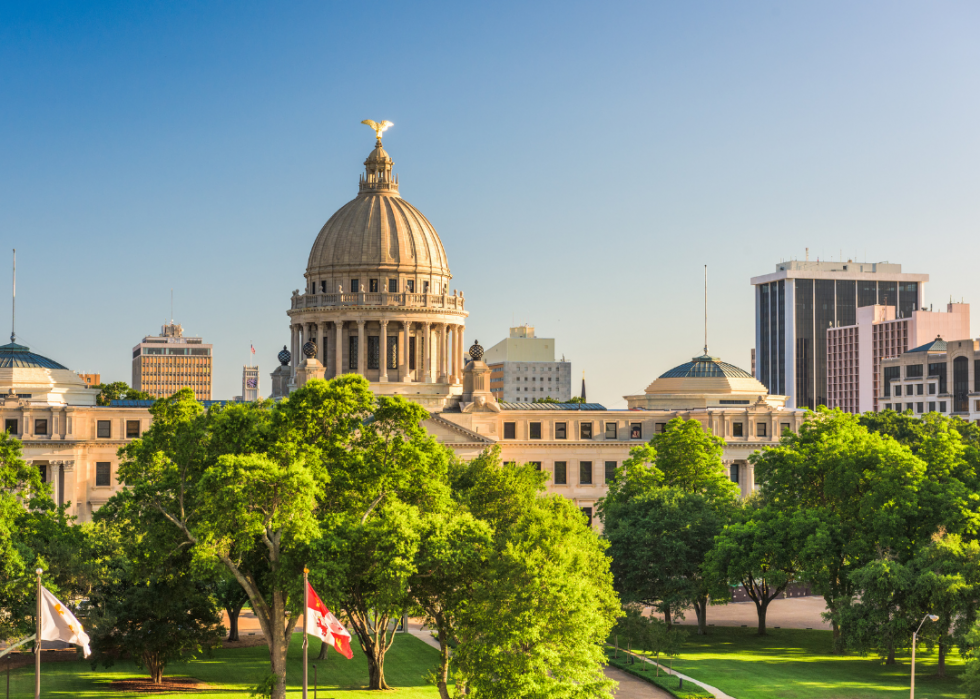
#38. Mississippi
- Internet availability for education purposes:
--- Always: 76.3%; Usually: 17.3%; Sometimes: 5.6%
- Computer availability for education purposes:
--- Always: 77.5%, Usually: 15.0%, Sometimes: 1.7%
- Who pays for education-related internet service:
--- Household or family: 88.1%; Child’s school or school district: 0.9%; Another source: 3.1%; Internet services not available in home: 6.1%
With many rural students, Mississippi has found it challenging to get students online during the pandemic. That said, just 5.6% of those surveyed said they only have the internet sometimes available for educational purposes.

#37. Utah
- Internet availability for education purposes:
--- Always: 76.4%; Usually: 16.9%; Sometimes: 3.8%
- Computer availability for education purposes:
--- Always: 70.8%, Usually: 20.7%, Sometimes: 5.4%
- Who pays for education-related internet service:
--- Household or family: 95.0%; Child’s school or school district: 0.9%; Another source: 2.3%; Internet services not available in home: 1.0%
Murray, Utah’s school district made national news in January 2021 when it unveiled a first of its kind, specially made LTE internet network for its students. All Murray students can access the network for free.

#36. New Mexico
- Internet availability for education purposes:
--- Always: 76.8%; Usually: 16.1%; Sometimes: 6.0%
- Computer availability for education purposes:
--- Always: 86.7%, Usually: 10.9%, Sometimes: 1.3%
- Who pays for education-related internet service:
--- Household or family: 93.6%; Child’s school or school district: 6.7%; Another source: 3.8%; Internet services not available in home: data not available
New Mexico’s rural students have struggled to get and stay online during the pandemic. One district offered USB-equipped slap bracelets that students could use to download lessons from hotspots before taking them home to complete on school computers.

#35. Colorado
- Internet availability for education purposes:
--- Always: 77.1%; Usually: 15.9%; Sometimes: 3.8%
- Computer availability for education purposes:
--- Always: 80.4%, Usually: 10.3%, Sometimes: 6.3%
- Who pays for education-related internet service:
--- Household or family: 96.2%; Child’s school or school district: 4.3%; Another source: 0.1%; Internet services not available in home: data not available
Colorado allocated $2 million in a special fund for getting students online, called the Connecting Colorado Students Grant. State officials said that racial and socioeconomic disparities were represented in the state’s percentages of students with internet access.

#34. New York
- Internet availability for education purposes:
--- Always: 77.7%; Usually: 16.2%; Sometimes: 4.6%
- Computer availability for education purposes:
--- Always: 76.7%, Usually: 15.1%, Sometimes: 3.7%
- Who pays for education-related internet service:
--- Household or family: 90.5%; Child’s school or school district: 10.0%; Another source: 2.4%; Internet services not available in home: 3.0%
In April 2021, New York Gov. Andrew Cuomo announced a new requirement that all internet providers offer low-cost options for New York residents with limited income. The new law caps the cost of internet access at just $15 a month.

#33. California
- Internet availability for education purposes:
--- Always: 78.4%; Usually: 14.7%; Sometimes: 1.9%
- Computer availability for education purposes:
--- Always: 82.8%, Usually: 10.8%, Sometimes: 1.6%
- Who pays for education-related internet service:
--- Household or family: 92.4%; Child’s school or school district: 1.9%; Another source: 3.3%; Internet services not available in home: 0.2%
In April 2020, Google offered to help bolster children’s internet access for remote schooling. California’s population of about 40 million people is spread out, from dense urban areas to remote and rural locations with little access.

#32. Kentucky
- Internet availability for education purposes:
--- Always: 79.0%; Usually: 14.2%; Sometimes: 4.7%
- Computer availability for education purposes:
--- Always: 72.2%, Usually: 20.4%, Sometimes: 5.8%
- Who pays for education-related internet service:
--- Household or family: 96.0%; Child’s school or school district: 0.6%; Another source: 0.3%; Internet services not available in home: 0.5%
Kentucky spent $8 million to help introduce a cap on internet costs to just $10 a month for low-income families. Many of Kentucky’s students live in rural districts with lower access to the internet overall.

#31. Pennsylvania
- Internet availability for education purposes:
--- Always: 79.5%; Usually: 10.7%; Sometimes: 2.8%
- Computer availability for education purposes:
--- Always: 83.6%, Usually: 12.3%, Sometimes: 1.2%
- Who pays for education-related internet service:
--- Household or family: 90.1%; Child’s school or school district: 0.9%; Another source: 1.1%; Internet services not available in home: data not available
Pennsylvania’s 500 school districts opted to go online very quickly at the beginning of the pandemic. They ran into trouble when plans to install hotspots ran into shortages and other problems.

#30. Minnesota
- Internet availability for education purposes:
--- Always: 79.6%; Usually: 17.4%; Sometimes: 0.1%
- Computer availability for education purposes:
--- Always: 84.4%, Usually: 12.4%, Sometimes: 0.8%
- Who pays for education-related internet service:
--- Household or family: 96.6%; Child’s school or school district: 0.3%; Another source: 0.6%; Internet services not available in home: 0.5%
About 3% of Minnesota’s students didn’t have internet access when schools went online in spring 2020. That number increases to 17% of families in rural communities around the state.
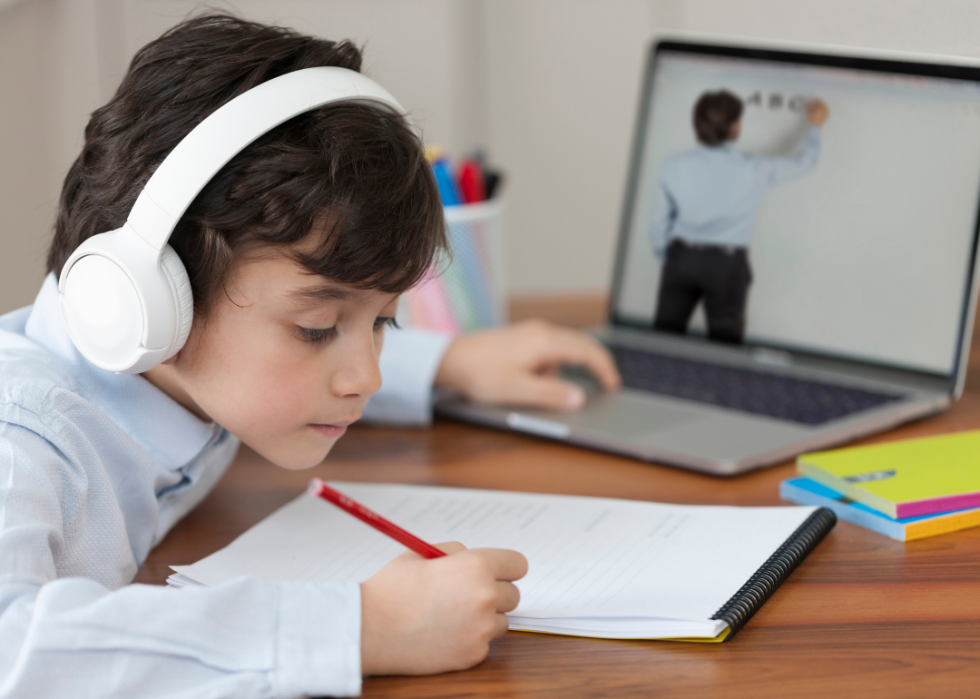
#29. Hawaii
- Internet availability for education purposes:
--- Always: 79.8%; Usually: 16.4%; Sometimes: 1.2%
- Computer availability for education purposes:
--- Always: 75.1%, Usually: 18.1%, Sometimes: 4.1%
- Who pays for education-related internet service:
--- Household or family: 95.0%; Child’s school or school district: 0.6%; Another source: 0.5%; Internet services not available in home: 2.1%
Hawaii’s population is split between more affluent school districts, with more reliable internet, and those in less funded school districts. A group called Hawaii Kids Can used buses as portable hotspots to park in areas hardest hit by lack of internet service.

#28. Connecticut
- Internet availability for education purposes:
--- Always: 80.0%; Usually: 14.4%; Sometimes: 2.6%
- Computer availability for education purposes:
--- Always: 91.3%, Usually: 3.7%, Sometimes: 1.4%
- Who pays for education-related internet service:
--- Household or family: 95.7%; Child’s school or school district: 1.1%; Another source: 0.6%; Internet services not available in home: data not available
Connecticut brought almost all of its school children online by October 2020, with virtually every student having a laptop and high-speed internet access for remote learning. This was with the help of CARES as well as private nonprofit funding.
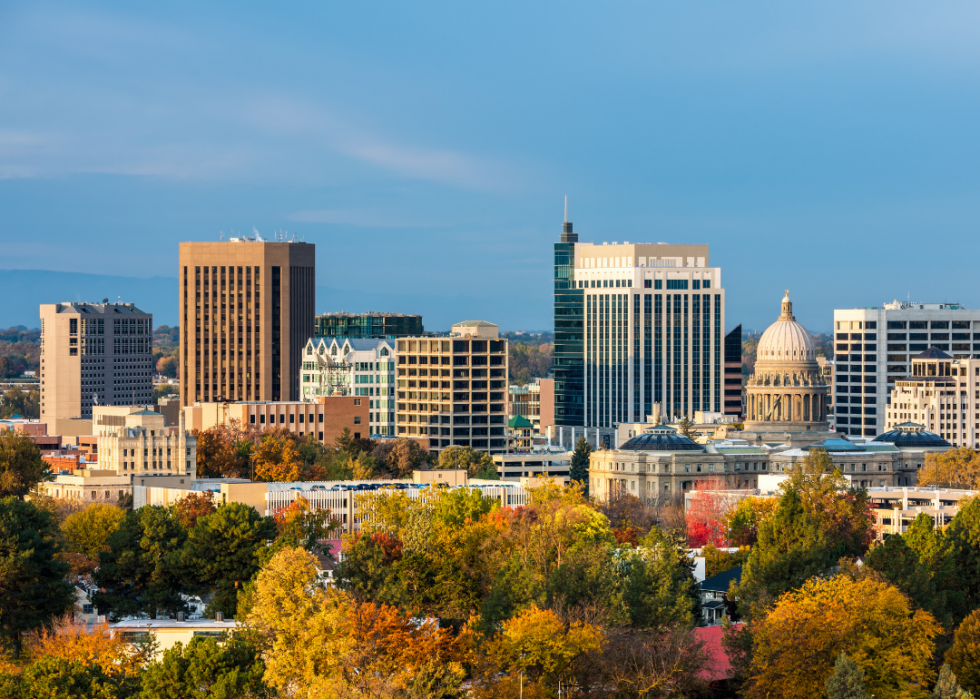
#27. Idaho
- Internet availability for education purposes:
--- Always: 80.1%; Usually: 17.1%; Sometimes: 1.5%
- Computer availability for education purposes:
--- Always: 70.7%, Usually: 22.5%, Sometimes: 4.9%
- Who pays for education-related internet service:
--- Household or family: 93.8%; Child’s school or school district: 2.8%; Another source: 0.9%; Internet services not available in home: 1.7%
In spring 2020, Idaho school officials called thousands of students’ families to assess everyone’s internet access. The Boise district alone has 25,000 students who had to be contacted and assessed.

#26. Vermont
- Internet availability for education purposes:
--- Always: 80.7%; Usually: 9.2%; Sometimes: 2.0%
- Computer availability for education purposes:
--- Always: 81.2%, Usually: 9.0%, Sometimes: 2.4%
- Who pays for education-related internet service:
--- Household or family: 91.8%; Child’s school or school district: data not available; Another source: 0.5%; Internet services not available in home: 2.0%
In Vermont, providers offered services like free Wi-Fi and no late fees to help the state’s residents stay online for schooling. About 70,000 Vermont residences don’t have access to broadband.

#25. Michigan
- Internet availability for education purposes:
--- Always: 80.7%; Usually: 10.7%; Sometimes: 4.2%
- Computer availability for education purposes:
--- Always: 87.3%, Usually: 5.8%, Sometimes: 3.4%
- Who pays for education-related internet service:
--- Household or family: 94.6%; Child’s school or school district: 1.5%; Another source: data not available; Internet services not available in home: 3.2%
As part of a deal struck with AT&T, 4,000 at risk students in Michigan received new internet access in April 2021. Providers in Michigan offer internet access for as low as $15 or $10 to low-income families.

#24. Arizona
- Internet availability for education purposes:
--- Always: 80.8%; Usually: 10.8%; Sometimes: 4.3%
- Computer availability for education purposes:
--- Always: 76.2%, Usually: 11.7%, Sometimes: 5.7%
- Who pays for education-related internet service:
--- Household or family: 92.7%; Child’s school or school district: 3.9%; Another source: 1.7%; Internet services not available in home: 0.2%
Arizona worked with a group of organizations to blanket the state with free Wi-Fi hotspots in response to the pandemic. About 30% of Arizona students don’t have internet access at home.

#23. Oklahoma
- Internet availability for education purposes:
--- Always: 81.2%; Usually: 10.6%; Sometimes: 5.1%
- Computer availability for education purposes:
--- Always: 80.1%, Usually: 11.8%, Sometimes: 4.5%
- Who pays for education-related internet service:
--- Household or family: 91.2%; Child’s school or school district: 3.1%; Another source: 2.5%; Internet services not available in home: 2.0%
Oklahoma has many rural school districts where students are more likely to lack internet access. In July 2020, the state announced that 175 districts were awarded grants to purchase internet access and devices for their students.

#22. Massachusetts
- Internet availability for education purposes:
--- Always: 81.3%; Usually: 13.8%; Sometimes: 1.6%
- Computer availability for education purposes:
--- Always: 86.8%, Usually: 11.5%, Sometimes: data not available
- Who pays for education-related internet service:
--- Household or family: 95.2%; Child’s school or school district: 0.2%; Another source: 0.7%; Internet services not available in home: data not available
About 9% of Massachusetts students didn’t have home internet access and 15% didn’t have their own computing device as of July 2020, when the Massachusetts Department of Elementary and Secondary Education released guidance on remote learning expectations. Districts were encouraged to make sure students would have reliable access to internet and adequate devices for the 2020–21 school year. School districts were offered $25 million through Remote Learning Technology grants.

#21. Texas
- Internet availability for education purposes:
--- Always: 81.5%; Usually: 14.1%; Sometimes: 2.6%
- Computer availability for education purposes:
--- Always: 80.9%, Usually: 11.3%, Sometimes: 3.2%
- Who pays for education-related internet service:
--- Household or family: 92.7%; Child’s school or school district: 2.0%; Another source: 0.8%; Internet services not available in home: 1.4%
Texas reported that 30% of students didn’t have regular home internet access before a $250 million initiative completed by organizations and companies in the state. Even that huge amount of money was only expected to bring 80% to 90% of the students total online.
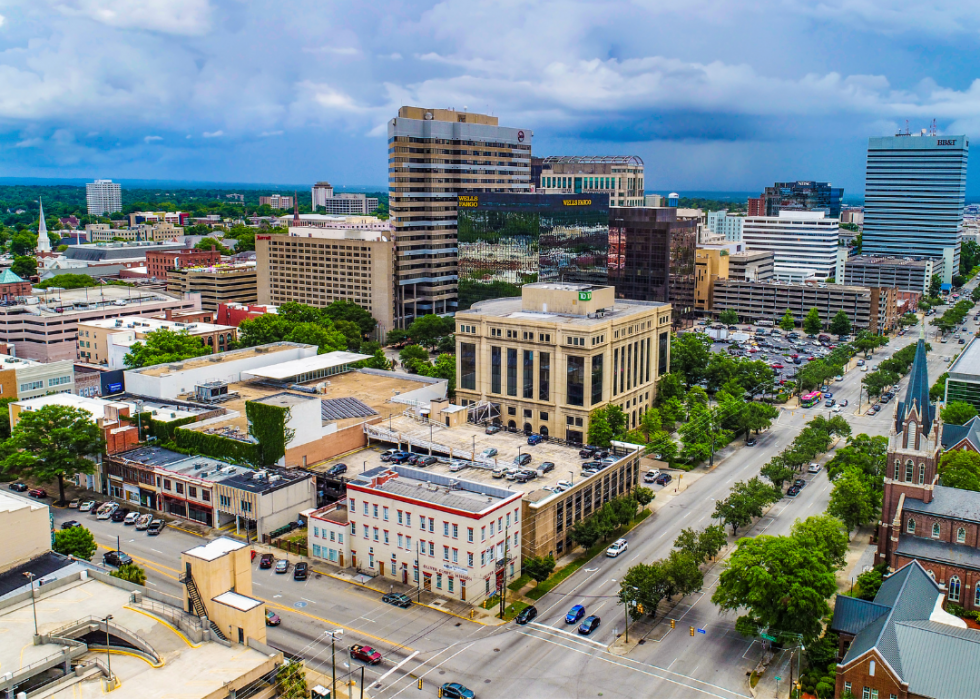
#20. South Carolina
- Internet availability for education purposes:
--- Always: 82.1%; Usually: 10.8%; Sometimes: 3.2%
- Computer availability for education purposes:
--- Always: 85.1%, Usually: 9.2%, Sometimes: 1.9%
- Who pays for education-related internet service:
--- Household or family: 92.4%; Child’s school or school district: 2.6%; Another source: 2.3%; Internet services not available in home: data not available
South Carolina reported about 650,000 residents without broadband internet access in August 2020, when 57,000 people applied for broadband assistance with the state. Its school districts are a mix of rural and urban schools with very different needs.

#19. Washington DC
- Internet availability for education purposes:
--- Always: 82.6%; Usually: 11.1%; Sometimes: data not available
- Computer availability for education purposes:
--- Always: 93.2%, Usually: 1.3%, Sometimes: data not available
- Who pays for education-related internet service:
--- Household or family: 88.1%; Child’s school or school district: 3.9%; Another source: 0.3%; Internet services not available in home: data not available
Washington D.C. spent $3.3 million to get 25,000 residents online for free in time for online schooling in the fall 2020. The charter system alone was unable to reach more than 2% of its 45,000 students to assess their internet.
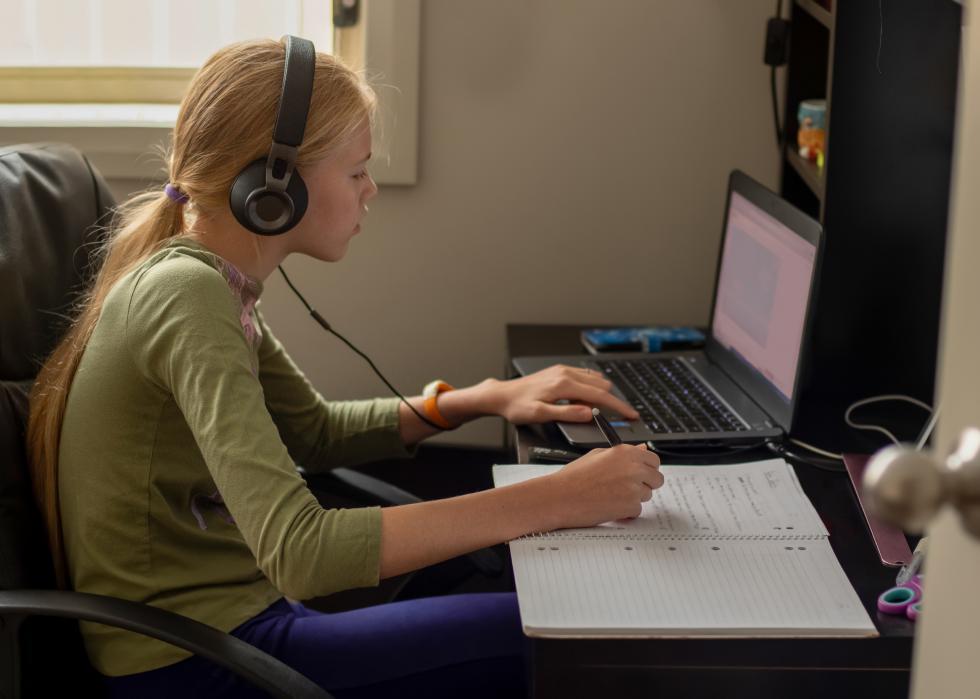
#18. Missouri
- Internet availability for education purposes:
--- Always: 83.0%; Usually: 9.7%; Sometimes: 2.8%
- Computer availability for education purposes:
--- Always: 88.2%, Usually: 9.2%, Sometimes: 1.7%
- Who pays for education-related internet service:
--- Household or family: 90.1%; Child’s school or school district: 3.1%; Another source: data not available; Internet services not available in home: 4.3%
Some schools in Missouri joined Utah in starting custom internet networks to try to bring more students online for remote learning. Pittsburg, Missouri, brought 500 more families online by installing a public fiber network.

#17. Maine
- Internet availability for education purposes:
--- Always: 83.4%; Usually: 6.7%; Sometimes: 9.5%
- Computer availability for education purposes:
--- Always: 86.6%, Usually: 10.8%, Sometimes: 2.2%
- Who pays for education-related internet service:
--- Household or family: 99.0%; Child’s school or school district: data not available; Another source: 0.6%; Internet services not available in home: data not available
Maine was served by the national Keep Americans Connected Pledge, which many companies signed to stop shutoffs for Americans who couldn’t make payments. Service providers also offered reduced cost or free access for some amount of time for Maine residents.
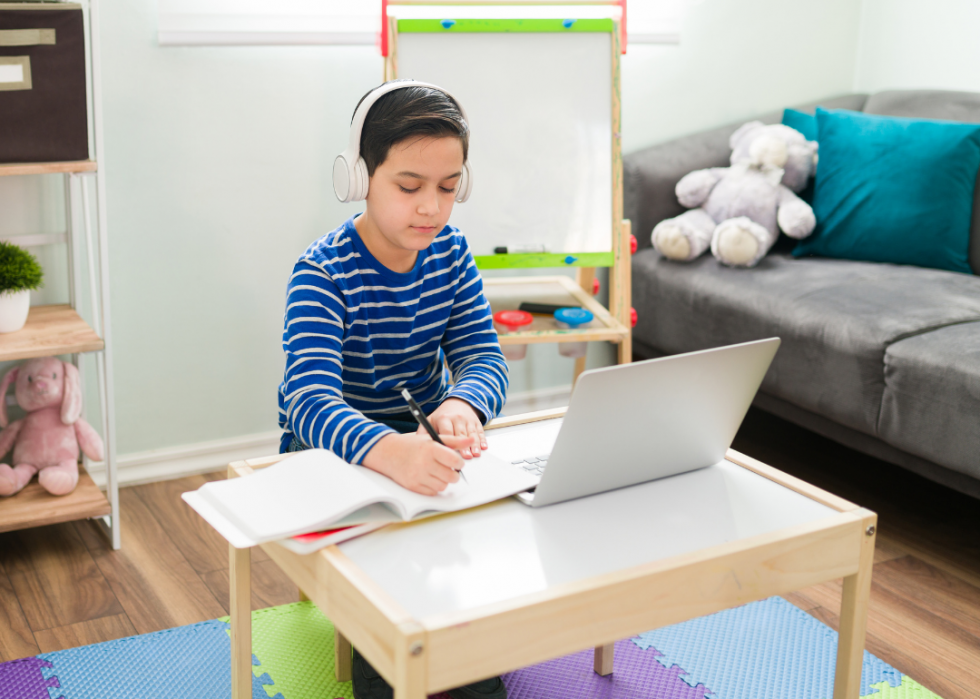
#16. Louisiana
- Internet availability for education purposes:
--- Always: 83.5%; Usually: 12.9%; Sometimes: 2.8%
- Computer availability for education purposes:
--- Always: 76.2%, Usually: 18.2%, Sometimes: 4.1%
- Who pays for education-related internet service:
--- Household or family: 97.8%; Child’s school or school district: 4.3%; Another source: 0.7%; Internet services not available in home: 0.5%
In August 2020, about 25% of Louisiana students lacked internet access to be able to participate in remote learning. The state has a broad mix of urban and rural students with a variety of needs.

#15. Tennessee
- Internet availability for education purposes:
--- Always: 83.6%; Usually: 10.0%; Sometimes: 2.7%
- Computer availability for education purposes:
--- Always: 75.4%, Usually: 21.5%, Sometimes: 2.4%
- Who pays for education-related internet service:
--- Household or family: 91.6%; Child’s school or school district: 4.7%; Another source: 0.1%; Internet services not available in home: 2.3%
Students in Chattanooga had internet provided to them by local service provider EPB, who offered up to 100 megabytes per second to students who also qualified for reduced cost lunch. The project was funded by a coalition of local organizations.

#14. Rhode Island
- Internet availability for education purposes:
--- Always: 83.6%; Usually: 11.0%; Sometimes: 4.6%
- Computer availability for education purposes:
--- Always: 79.2%, Usually: 12.2%, Sometimes: 5.8%
- Who pays for education-related internet service:
--- Household or family: 95.1%; Child’s school or school district: data not available; Another source: data not available; Internet services not available in home: data not available
Rhode Island arranged for students to receive a free month of internet if schools sent in lists of those without internet access at home. Other services offered competing free offers to low-income families in the state.

#13. Iowa
- Internet availability for education purposes:
--- Always: 84.3%; Usually: 8.3%; Sometimes: 6.6%
- Computer availability for education purposes:
--- Always: 86.9%, Usually: 9.0%, Sometimes: 2.5%
- Who pays for education-related internet service:
--- Household or family: 97.5%; Child’s school or school district: 5.3%; Another source: 0.6%; Internet services not available in home: 0.5%
In Iowa’s Sioux City district, between 20% and 30% of students didn’t have fast enough internet to do remote learning. A school drove Wi-Fi-equipped buses into vulnerable neighborhoods to help users get online through hotspots.

#12. New Jersey
- Internet availability for education purposes:
--- Always: 84.5%; Usually: 11.4%; Sometimes: 1.8%
- Computer availability for education purposes:
--- Always: 86.0%, Usually: 9.8%, Sometimes: 1.9%
- Who pays for education-related internet service:
--- Household or family: 94.5%; Child’s school or school district: 1.2%; Another source: 0.8%; Internet services not available in home: 1.5%
In March 2021, New Jersey announced that it brought all students online for remote learning. That follows a $54 million grant in July 2020 to help close the digital divide for those without internet access or devices.

#11. Georgia
- Internet availability for education purposes:
--- Always: 84.6%; Usually: 9.9%; Sometimes: 1.5%
- Computer availability for education purposes:
--- Always: 81.2%, Usually: 13.8%, Sometimes: 3.0%
- Who pays for education-related internet service:
--- Household or family: 92.7%; Child’s school or school district: 2.3%; Another source: data not available; Internet services not available in home: 2.2%
AT&T donated 448 longer distance Wi-Fi Ranger devices to 36 Georgia school districts to help get more students online for remote learning. Georgia has many rural districts where internet access is even lower than for the rest of the population.

#10. Indiana
- Internet availability for education purposes:
--- Always: 85.0%; Usually: 7.3%; Sometimes: 4.3%
- Computer availability for education purposes:
--- Always: 84.1%, Usually: 10.0%, Sometimes: 3.9%
- Who pays for education-related internet service:
--- Household or family: 95.9%; Child’s school or school district: 0.3%; Another source: data not available; Internet services not available in home: 0.9%
In August 2020, Indiana reported that 84,000 students didn’t have internet access at home. Up to 50% in some districts reported having spotty internet that didn’t support remote learning technology.
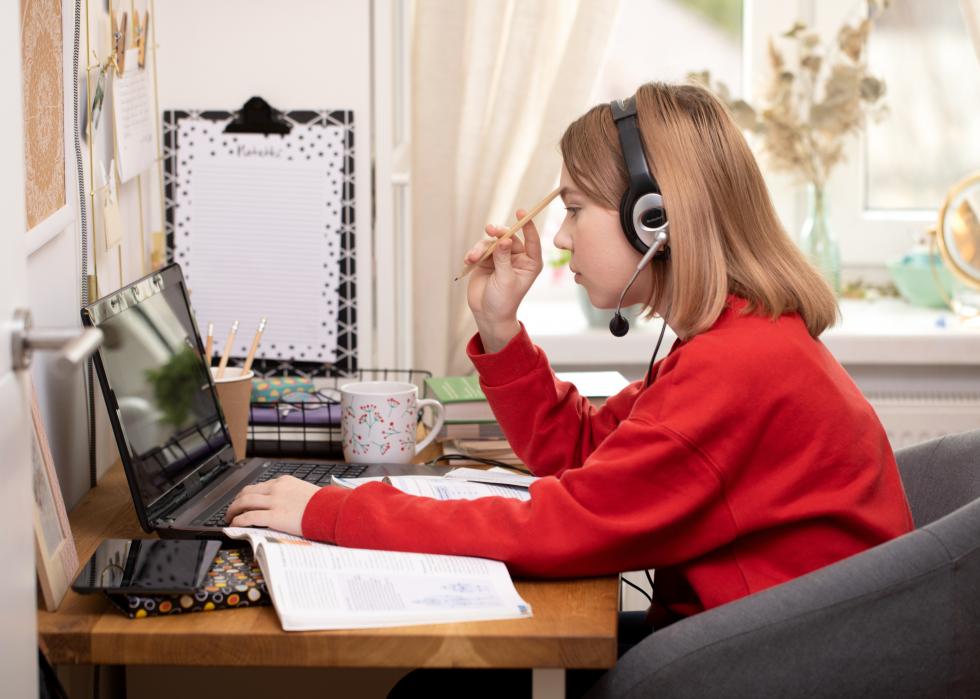
#9. Maryland
- Internet availability for education purposes:
--- Always: 85.1%; Usually: 12.5%; Sometimes: 0.4%
- Computer availability for education purposes:
--- Always: 90.1%, Usually: 6.6%, Sometimes: 1.3%
- Who pays for education-related internet service:
--- Household or family: 97.1%; Child’s school or school district: 1.6%; Another source: 0.1%; Internet services not available in home: data not available
Maryland reported in August 2020 that 324,000 rural residents didn't have access to high-speed internet, leaving students in a jam for remote learning. The state plans to build a futuristic Wi-Fi network to reach all students, but it won’t be completed until at least late in 2021.

#8. New Hampshire
- Internet availability for education purposes:
--- Always: 85.4%; Usually: 10.8%; Sometimes: 0.8%
- Computer availability for education purposes:
--- Always: 85.7%, Usually: 10.7%, Sometimes: 0.5%
- Who pays for education-related internet service:
--- Household or family: 92.3%; Child’s school or school district: 1.9%; Another source: 0.2%; Internet services not available in home: data not available
New Hampshire received $16 million in CARES funding to build a new fiber network that will bring 5,500 households and businesses online with high speed internet. New Hampshire has many students in rural or remote locations with higher percentages of those without internet access.

#7. Wyoming
- Internet availability for education purposes:
--- Always: 85.5%; Usually: 10.6%; Sometimes: 0.4%
- Computer availability for education purposes:
--- Always: 69.5%, Usually: 19.8%, Sometimes: 0.9%
- Who pays for education-related internet service:
--- Household or family: 97.3%; Child’s school or school district: data not available; Another source: data not available; Internet services not available in home: 1.0%
In May 2020, Wyoming passed an emergency measure to give residents $50 off their internet bill. Eligible residents include those who receive SNAP benefits, reduced or free school lunch, or Medicaid benefits, for example.

#6. Washington
- Internet availability for education purposes:
--- Always: 85.8%; Usually: 10.3%; Sometimes: 1.4%
- Computer availability for education purposes:
--- Always: 93.4%, Usually: 3.5%, Sometimes: 0.6%
- Who pays for education-related internet service:
--- Household or family: 94.4%; Child’s school or school district: 3.8%; Another source: 0.9%; Internet services not available in home: 0.2%
Washington state has many students in rural districts. In an informal survey, representatives from 20 of these districts said that less than half their students have internet access required for remote learning.

#5. Virginia
- Internet availability for education purposes:
--- Always: 86.1%; Usually: 9.7%; Sometimes: 2.0%
- Computer availability for education purposes:
--- Always: 90.6%, Usually: 4.5%, Sometimes: 2.6%
- Who pays for education-related internet service:
--- Household or family: 95.4%; Child’s school or school district: 2.3%; Another source: 0.6%; Internet services not available in home: 0.4%
A majority of Virginia’s public schools reported in August 2020 that 20% of their students didn’t have internet access at home. One Virginia county set up all their public schools as free hotspots for families who can drive up for internet access.
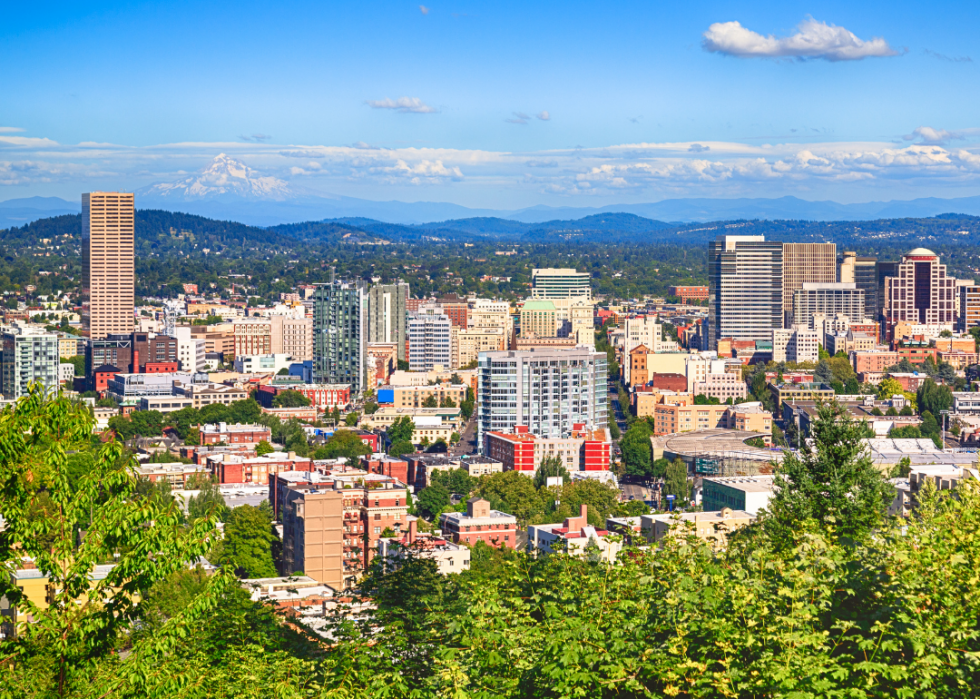
#4. Oregon
- Internet availability for education purposes:
--- Always: 86.8%; Usually: 7.4%; Sometimes: 1.8%
- Computer availability for education purposes:
--- Always: 87.8%, Usually: 7.8%, Sometimes: 0.8%
- Who pays for education-related internet service:
--- Household or family: 92.4%; Child’s school or school district: 3.0%; Another source: 1.6%; Internet services not available in home: 1.0%
Oregon has many students in rural districts with lower rates of internet access. In rural Sandy, the local internet service provider set up free Wi-Fi hotspots all around town in August 2020, including in the closed school.
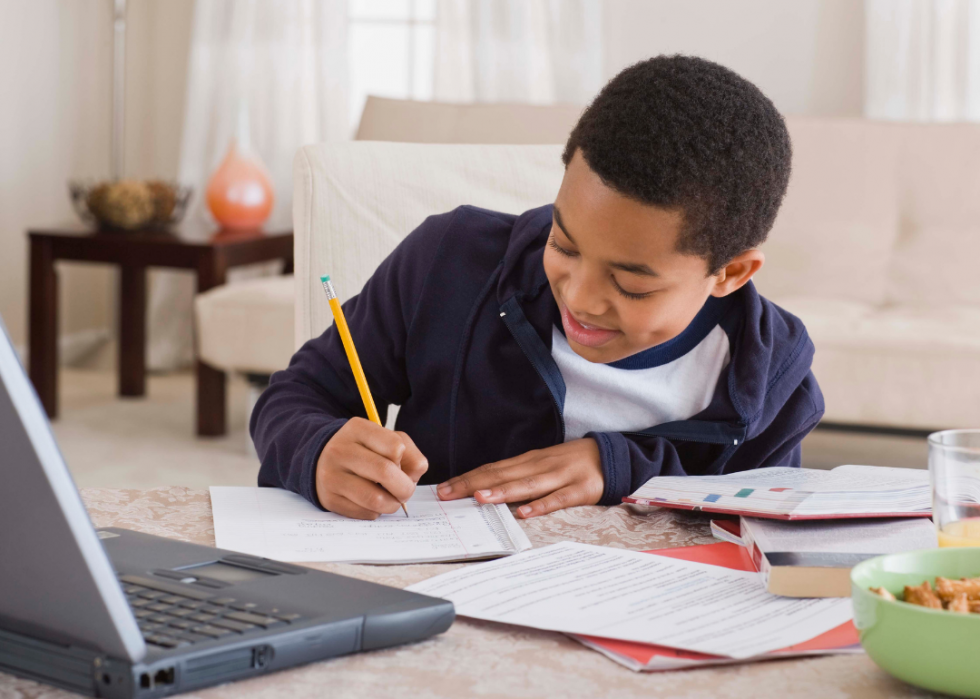
#3. South Dakota
- Internet availability for education purposes:
--- Always: 88.6%; Usually: 6.7%; Sometimes: 2.2%
- Computer availability for education purposes:
--- Always: 60.5%, Usually: 28.5%, Sometimes: 8.5%
- Who pays for education-related internet service:
--- Household or family: 98.3%; Child’s school or school district: data not available; Another source: data not available; Internet services not available in home: data not available
South Dakota reported in November 2020 that all qualifying K-12 students would have free broadband internet access for the rest of the school year. To qualify, students need to also qualify for free or reduced school lunch and not have an existing internet service provider.

#2. Delaware
- Internet availability for education purposes:
--- Always: 91.1%; Usually: 5.8%; Sometimes: 2.1%
- Computer availability for education purposes:
--- Always: 92.3%, Usually: 4.6%, Sometimes: 2.1%
- Who pays for education-related internet service:
--- Household or family: 96.1%; Child’s school or school district: 1.4%; Another source: 1.9%; Internet services not available in home: 0.7%
Delaware spent $20 million in CARES funding to help get more students online for the 2020-2021 school year. Delaware’s two more rural lower counties received 15 new broadband towers that were finished in 2020.

#1. North Dakota
- Internet availability for education purposes:
--- Always: 93.8%; Usually: 4.0%; Sometimes: 0.7%
- Computer availability for education purposes:
--- Always: 91.5%, Usually: 4.3%, Sometimes: 2.3%
- Who pays for education-related internet service:
--- Household or family: 95.7%; Child’s school or school district: 0.8%; Another source: 2.0%; Internet services not available in home: data not available
North Dakota’s Native American reservations have a lower rate of internet access than surrounding communities. In April 2021, the state reported that the Standing Rock Sioux Tribe has partnered with other tribes and telecommunication providers to get 15,000 tribal members online.
This story was produced and distributed in partnership with Stacker Studio.



